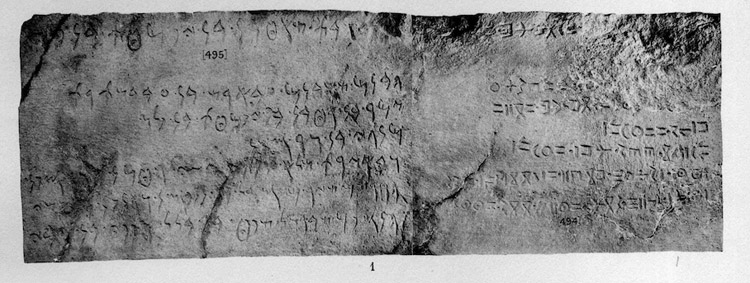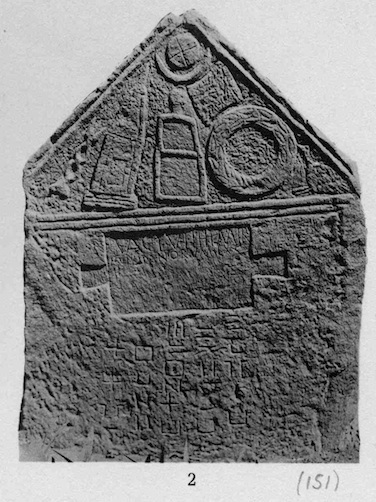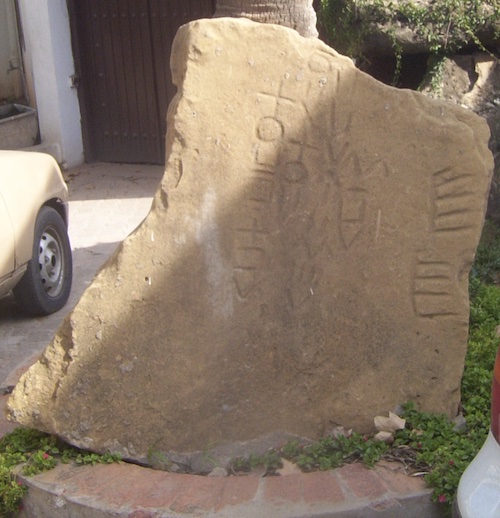Examples of writing
RIL 1, Pl. 1.1

Source: Fonte
This bilingual inscription (RIL 1, Pl. 1.1; KAI 100) from a mausoleum at Dougga/Tbgg (Tunisia) was the first Libyco-Berber inscription to come to the attention of Western scholars, in 1631. It was brought to the British Museum in 1842 by an English consul. It consists of two stone blocks 70 cm high - Libyco-Berber on the right (99 cm long), Punic on the left (1.14 m long.) Like other inscriptions from Dougga, but unusually for Libyco-Berber as a whole, it marks word dividers, using a dot. The Punic text (on the left) says:
[mn]ṣbt š'ṭbn bn ypmṭt bn plw
hbnm š'bnm ʕb'rš bn ʕbdštrt
zmr bn 'ṭbn bn ypmṭt bn plw
mngy bn wrsbn
wb'zrt šl' **t* zzy wṭmn wwrskn
hḥršm šyr msdl bn nnpsn w'nkn b[n] 'šy
hnskm šbrzl špṭ bll wppy bn bby
This is translated as "The monument of 'ṭbn son of Ypmṭt son of Plw. Builders of the stones: ʕb'rš son of ʕbdštrt; Zmr son of 'ṭbn son of Ypmṭt son of Plw; Mngy son of Wrsbn. And for its ???, Zzy son of Ṭmn and Wrskn. Workers of the wood: Msdl son of Nnpsn and 'nkn son of 'šy. Casters of the iron: Šfṭ son of Bll and Ppy son of Bby."
The Berber text reads:
****N WYFMṬT W***
****DRŠ WWDŠTR
*****BN WYFMṬṮ WFLW
MNGY WWRSKN
KSLNS ŻŻY ṬMN WRSKN
NBBN NŠ[Q]RH MSDL WNNFSN NKN WŠY
NB*N NZLH ŠFṬ WBLL FFY WBBY
RIL 151, Pl. V.2

This inscription (RIL 151, Pl. V.2 = CIL 5220 / 17395) is a Latin-Libyco-Berber bilingual discovered at Kef Beni Feredj in the Cheffia valley in northeastern Algeria near the Tunisian border. It is currently in Annaba Museum.
The Latin text is
SACTUT•IHIMIR F•VIXIT•ANORVM•LXX H[SE]
(Sactut son of Ihimir lived 70 years. [He is buried here.]).
The Libyco-Berber text says
ZKTT WYMR MTYBLH MSWH MNKDH,
whose first two words are of course to be read Zaktut son of Iyimir. MTYBLH is probably a tribal name or location, identified by Horn & Rüger (1979) with the nearby Latin place name Tenelium (*Tebelium.) The last two words, MSWH MNKDH, are common on funerary inscriptions; their meaning is controversial.
RIL 858

Source: photo by Lameen Souag
This inscription (RIL 858) is a monolingual funerary inscription discovered on the capstone of a dolmen in Ouled Fayet, now a southwestern suburb of Algiers, in 1867. It is now in the National Museum of Antiquities and Ancient Islamic Art in Algiers. As is typical for the region, it is written in the poorly deciphered "western" or "Masaesylian" Libyco-Berber script, and therefore includes several characters whose reading has not been established, such as the chevron (V). In a broader study of inscriptions containing the recurring word Vⵎⵜ (as in the leftmost line), Rebuffat (2012) proposes the following partial reading of this inscription (with ? for characters whose reading he could not identify):
MKY*KNTRY
W RY? WR
MT2ZW? MWW
MTNZ
No translation will be attempted here, but Rebuffat sees the widely attested words which he reads as MKY (Vⵎⵜ) and MWW (Vǁǁ) as probably titles/ranks, while W is certainly "son (of)". Most of the remainder is likely personal names. In the current state of research, this and any other reading of western Libyco-Berber inscriptions must be taken with a grain of salt.